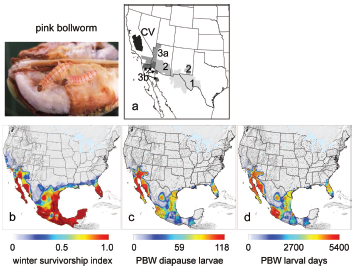Invasive species: why the biology matters
Using published bi- and tri-trophic physiologically-based demographic system models having similar sub components, the geographic distributions and relative abundance (a measure of invasiveness) of six invasive herbivorous insect species is assessed prospectively across the United States and Mexico. The models used are mechanistic descriptions of the weather-driven biology of the species. The plant hosts and insect species included in the study are: (1) cotton/pink bollworm, (2) a fruit tree host/Mediterranean fruit fly, (3) olive/olive fly, (4) a perennial host/light brown apple moth; (5) grapevine/glassy-winged sharpshooter and its two egg parasitoids, (6) grapevine/European grapevine moth. All of these species are currently or have been targets for eradication. The goal of the analyses is to predict and explain prospectively the disparate distributions of the six species as a basis for examining eradication/containment efforts against them. The eradication of the new world screwworm is also reviewed in the discussion section because of its pivotal role in the development of the eradication paradigm.
Gutierrez A.P., Ponti L., 2013. Eradication of invasive species: why the biology matters. Environmental Entomology, 42: 395-411. http://dx.doi.org/10.1603/EN12018 | Open access
Gutierrez A.P., Ponti L., 2013. Eradication of invasive species: why the biology matters. Environmental Entomology, 42: 395-411. http://dx.doi.org/10.1603/EN12018 | Open access



Comments
Post a Comment